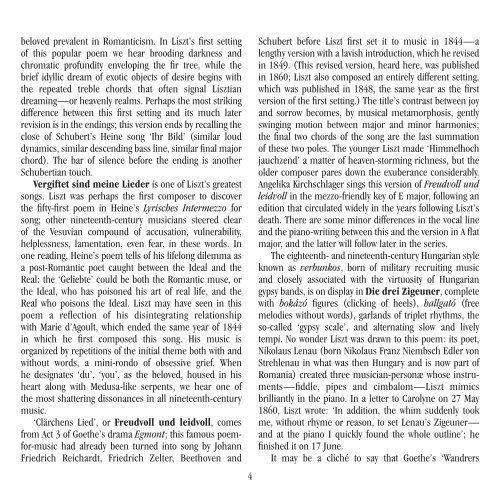Liszt: The Complete Songs, Vol. 2 - Angelika ... - Abeille Musique
Liszt: The Complete Songs, Vol. 2 - Angelika ... - Abeille Musique
Liszt: The Complete Songs, Vol. 2 - Angelika ... - Abeille Musique
Erfolgreiche ePaper selbst erstellen
Machen Sie aus Ihren PDF Publikationen ein blätterbares Flipbook mit unserer einzigartigen Google optimierten e-Paper Software.
eloved prevalent in Romanticism. In <strong>Liszt</strong>’s first setting<br />
of this popular poem we hear brooding darkness and<br />
chromatic profundity enveloping the fir tree, while the<br />
brief idyllic dream of exotic objects of desire begins with<br />
the repeated treble chords that often signal <strong>Liszt</strong>ian<br />
dreaming—or heavenly realms. Perhaps the most striking<br />
difference between this first setting and its much later<br />
revision is in the endings; this version ends by recalling the<br />
close of Schubert’s Heine song ‘Ihr Bild’ (similar loud<br />
dynamics, similar descending bass line, similar final major<br />
chord). <strong>The</strong> bar of silence before the ending is another<br />
Schubertian touch.<br />
Vergiftet sind meine Lieder is one of <strong>Liszt</strong>’s greatest<br />
songs. <strong>Liszt</strong> was perhaps the first composer to discover<br />
the fifty-first poem in Heine’s Lyrisches Intermezzo for<br />
song; other nineteenth-century musicians steered clear<br />
of the Vesuvian compound of accusation, vulnerability,<br />
helplessness, lamentation, even fear, in these words. In<br />
one reading, Heine’s poem tells of his lifelong dilemma as<br />
a post-Romantic poet caught between the Ideal and the<br />
Real: the ‘Geliebte’ could be both the Romantic muse, or<br />
the Ideal, who has poisoned his art of real life, and the<br />
Real who poisons the Ideal. <strong>Liszt</strong> may have seen in this<br />
poem a reflection of his disintegrating relationship<br />
with Marie d’Agoult, which ended the same year of 1844<br />
in which he first composed this song. His music is<br />
organized by repetitions of the initial theme both with and<br />
without words, a mini-rondo of obsessive grief. When<br />
he designates ‘du’, ‘you’, as the beloved, housed in his<br />
heart along with Medusa-like serpents, we hear one of<br />
the most shattering dissonances in all nineteenth-century<br />
music.<br />
‘Clärchens Lied’, or Freudvoll und leidvoll, comes<br />
from Act 3 of Goethe’s drama Egmont; this famous poemfor-music<br />
had already been turned into song by Johann<br />
Friedrich Reichardt, Friedrich Zelter, Beethoven and<br />
4<br />
Schubert before <strong>Liszt</strong> first set it to music in 1844—a<br />
lengthy version with a lavish introduction, which he revised<br />
in 1849. (This revised version, heard here, was published<br />
in 1860; <strong>Liszt</strong> also composed an entirely different setting,<br />
which was published in 1848, the same year as the first<br />
version of the first setting.) <strong>The</strong> title’s contrast between joy<br />
and sorrow becomes, by musical meta morphosis, gently<br />
swinging motion between major and minor harmonies;<br />
the final two chords of the song are the last summation<br />
of these two poles. <strong>The</strong> younger <strong>Liszt</strong> made ‘Himmelhoch<br />
jauchzend’ a matter of heaven-storming richness, but the<br />
older composer pares down the exuberance considerably.<br />
<strong>Angelika</strong> Kirchschlager sings this version of Freudvoll und<br />
leidvoll in the mezzo-friendly key of E major, following an<br />
edition that circulated widely in the years following <strong>Liszt</strong>’s<br />
death. <strong>The</strong>re are some minor differences in the vocal line<br />
and the piano-writing between this and the version in A flat<br />
major, and the latter will follow later in the series.<br />
<strong>The</strong> eighteenth- and nineteenth-century Hungarian style<br />
known as verbunkos, born of military recruiting music<br />
and closely associated with the virtuosity of Hun garian<br />
gypsy bands, is on display in Die drei Zigeuner, complete<br />
with bokázó figures (clicking of heels), hallgató (free<br />
melodies without words), garlands of triplet rhythms, the<br />
so-called ‘gypsy scale’, and alternating slow and lively<br />
tempi. No wonder <strong>Liszt</strong> was drawn to this poem: its poet,<br />
Nikolaus Lenau (born Nikolaus Franz Niembsch Edler von<br />
Strehlenau in what was then Hungary and is now part of<br />
Romania) created three musician-personæ whose instru -<br />
ments—fiddle, pipes and cimbalom—<strong>Liszt</strong> mimics<br />
brilliantly in the piano. In a letter to Carolyne on 27 May<br />
1860, <strong>Liszt</strong> wrote: ‘In addition, the whim suddenly took<br />
me, without rhyme or reason, to set Lenau’s Zigeuner—<br />
and at the piano I quickly found the whole outline’; he<br />
finished it on 17 June.<br />
It may be a cliché to say that Goethe’s ‘Wandrers
















